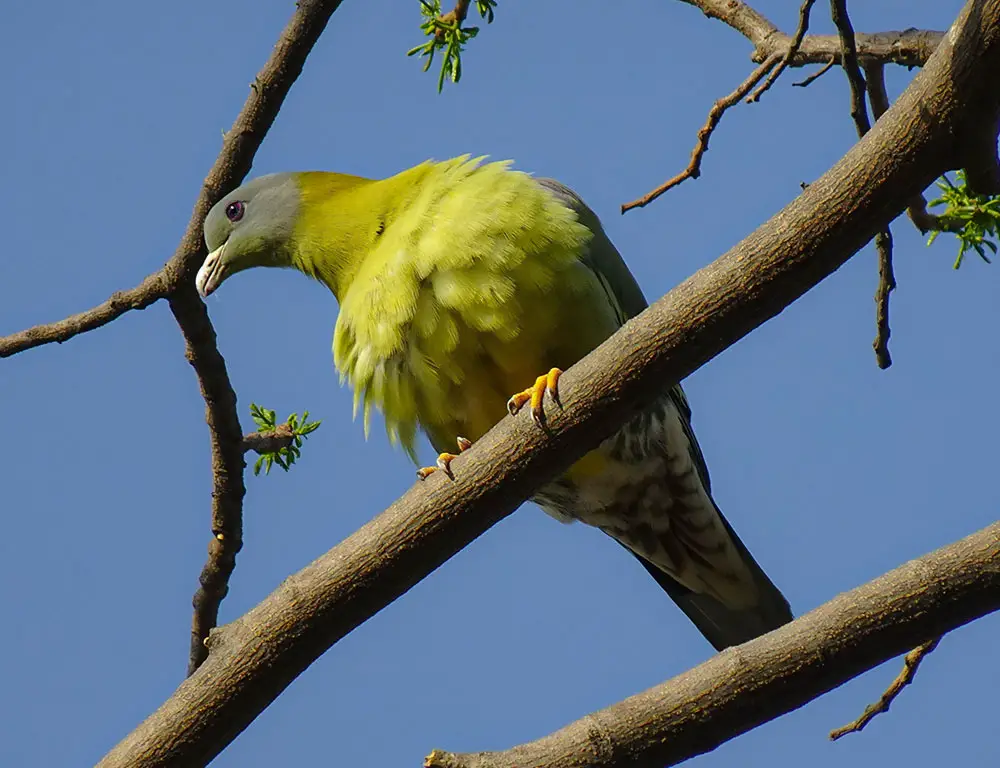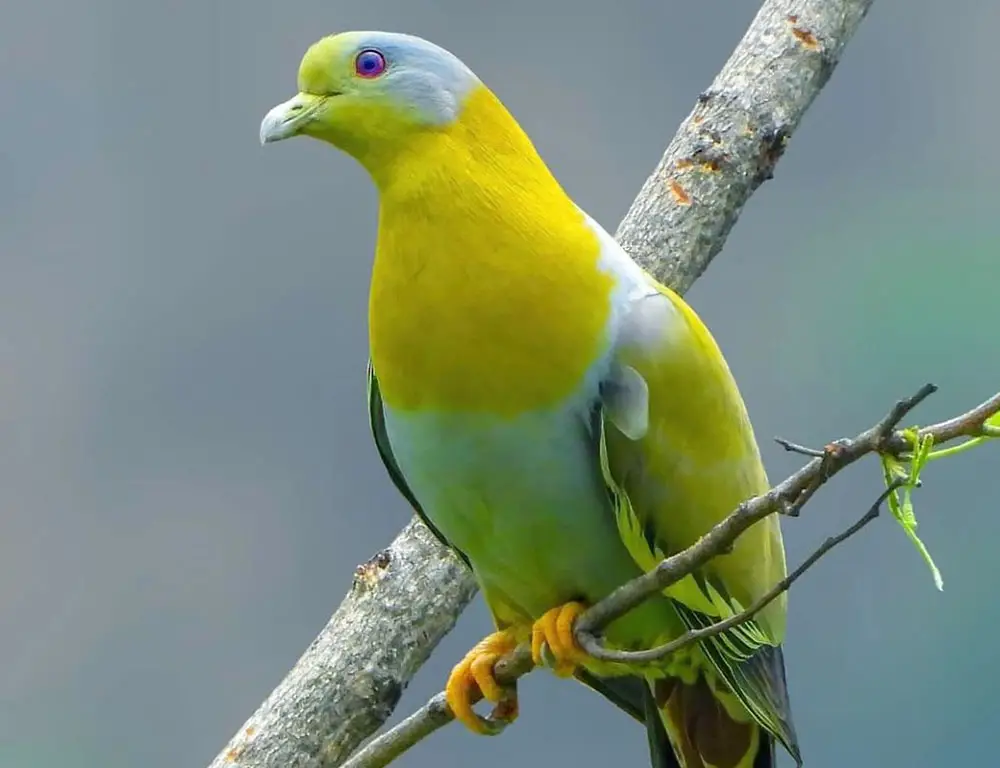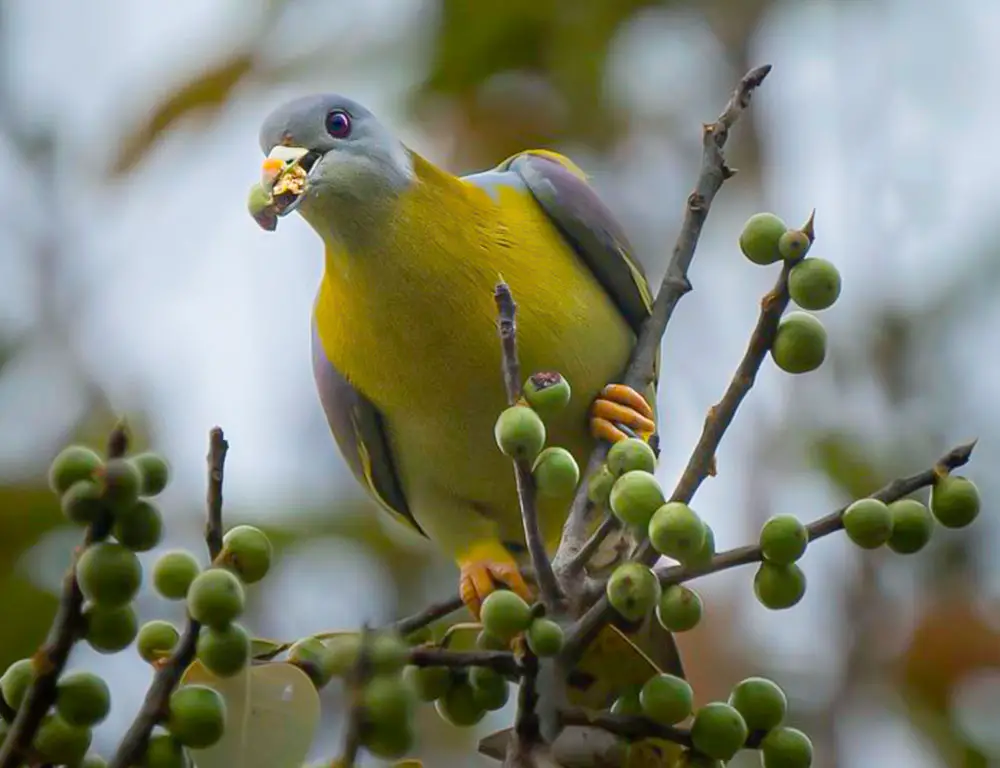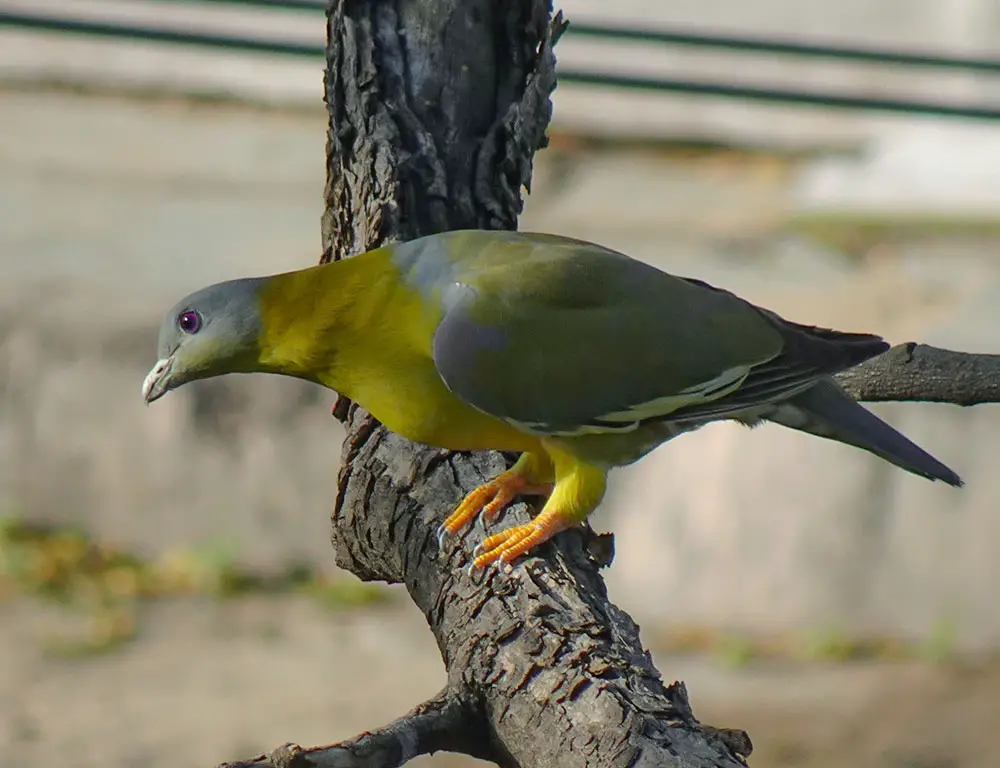The Yellow-Footed Green Pigeon, scientifically known as Treron phoenicoptera, captivates with its vibrant green plumage and striking yellow feet, making it a mesmerizing sight in the forests and woodlands of South Asia.
Beyond their arresting appearance, these pigeons play a vital role in the ecosystem by feasting on fruits and facilitating seed dispersal, thus contributing to biodiversity.
Despite their resemblance to city pigeons, Yellow-Footed Green Pigeons stand out as extraordinary creatures deserving our attention and respect.
As we embark on a journey into their world, we uncover the intricacies of their behavior, habitat, and conservation status, shedding light on preserving these brightly-colored avians for future generations to admire.

Physical Characteristics of the Yellow-Footed Green Pigeon
The Yellow-Footed Green Pigeon (Treron phoenicoptera) is renowned for its captivating physical attributes, contributing to its unique charm.
Here’s a breakdown of its fundamental physical characteristics:
Size
Yellow-Footed Green Pigeons are medium-sized birds, typically measuring between 29 and 33 centimeters (11 to 13 inches) in length. This places them more significant than the typical city pigeon but smaller than a crow.
Shape
They possess a robust yet sleek body shape characterized by a well-rounded body, slender wings, and a relatively short tail. This physique aids in their agility and maneuverability, especially within the dense foliage of their forest habitat.
Plumage and Coloration
- Upperparts: The upperparts of the Yellow-Footed Green Pigeon feature predominantly green plumage, enabling them to blend seamlessly into the verdant canopy of their habitat.
- Underparts: Their underparts boast a stunning array of colors. The colors transition into maroon-burgundy chests, starting with greyish-white throats, culminating in lemon-yellow bellies extending to their feet.
- Wing Feathers: The wing feathers exhibit a beautiful blue-grey tint, providing an exquisite contrast against the vibrant green body plumage.
- Sexual Dimorphism: While males and females display similar patterns, males exhibit more vibrant and colorful plumage than females.
Distinctive Features
The most striking feature of the Yellow-Footed Green Pigeon is its vibrant yellow feet, from which it derives its name. These bright yellow appendages stand out prominently against the bird’s green plumage, adding to its visual appeal.
Adaptations
The physical characteristics of the Yellow-Footed Green Pigeon are finely tuned to its arboreal lifestyle. Their compact body shape, slender wings, and vibrant coloration provide effective camouflage and agility among the foliage.
Habitat and Distribution of the Yellow-Footed Green Pigeon

The Yellow-Footed Green Pigeon (Treron phoenicoptera) primarily inhabits forested and wooded areas across South Asia. Here’s an overview of its habitat and distribution:
Geographic Range
The Yellow-Footed Green Pigeon is native to several South Asian countries, including India, Nepal, Sri Lanka, and Myanmar. It is also found in some areas of Bangladesh and Pakistan.
Preferred Habitat
- Forests and Woodlands: Yellow-Footed Green Pigeons are commonly found in various types of forests and woodlands, including deciduous forests, evergreen forests, and scrublands.
These habitats provide ample food resources in the form of fruits and berries, which are a staple of the pigeon’s diet. - Semi-Desert Areas: While primarily inhabited forested areas, Yellow-Footed Green Pigeons also occur in semi-desert regions, especially with scattered trees or vegetation.
Foraging Behavior
Within their habitat, Yellow-Footed Green Pigeons typically forage for fruits and berries in the upper branches of trees. However, they are also known to descend to the ground for fallen fruits or other food items.
Distribution Patterns
- Resident Species: Yellow-Footed Green Pigeons are resident species in many parts of their range, meaning they inhabit and breed in the same area throughout the year.
- Rare Visitors: In certain regions like Bangladesh and Pakistan, Yellow-Footed Green Pigeons may be considered rare visitors rather than resident species. This could be due to factors such as habitat availability and geographical barriers.
Human Impact
Habitat loss and degradation due to deforestation, urbanization, and agricultural expansion pose significant threats to Yellow-Footed Green Pigeon populations across their range.
Conservation efforts to preserve their forest habitats are crucial for ensuring their long-term survival.
Behavior and Diet of the Yellow-Footed Green Pigeon

The behavior and diet of the Yellow-Footed Green Pigeon (Treron phoenicoptera) are fascinating aspects of its biology, reflecting its adaptation to its natural environment.
Here’s a closer look at these aspects:
Feeding Habits
- Frugivorous Diet: The Yellow-Footed Green Pigeon primarily feeds on fruits such as berries, figs, and other wild fruits. Their specialized diet makes them essential agents of seed dispersal in their habitat, contributing to the maintenance of biodiversity.
- Omnivorous Behavior: While fruits are their main dietary component, Yellow-Footed Green Pigeons are not strictly limited to a fruit diet.
They may also consume insects or small reptiles, mainly when fruit availability is low. This omnivorous behavior reflects their adaptability in response to changing environmental conditions.
Foraging Behavior
- Tree Canopy Foragers: These pigeons are typically observed foraging for fruits in the upper branches of trees, where they can easily access ripe fruits. Their green plumage helps them blend into the foliage, providing camouflage while they feed.
- Ground Foraging: Despite their preference for tree canopies, Yellow-Footed Green Pigeons are also known to descend to the ground in search of fallen fruits or other food items. This behavior allows them to exploit a broader range of food resources within their habitat.
Social Behavior
- Flocking Behavior: Yellow-Footed Green Pigeons are social birds often observed in flocks, especially during non-breeding seasons. These flocks may consist of individuals of varying ages and sexes and may congregate around abundant food sources.
- Interactions with Other Species: While they may form mixed-species flocks with other bird species, Yellow-Footed Green Pigeons are generally peaceful and not known for aggressive behavior towards other birds.
Vocalization
Yellow-Footed Green Pigeons are relatively quiet and unobtrusive, Unlike other pigeon species known for their cooing calls. They may produce soft vocalizations but are not as vocal as some other bird species.
Conservation Status of the Yellow-Footed Green Pigeon

The conservation status of the Yellow-Footed Green Pigeon (Treron phoenicoptera) is of concern due to various threats facing its populations.
Here’s an overview of its conservation status and the challenges it faces:
IUCN Red List Status
As of the last assessment, the Yellow-Footed Green Pigeon is categorized as “Least Concern” on the International Union for Conservation of Nature (IUCN) Red List.
This designation suggests that the species is not currently facing immediate extinction risk on a global scale.
Habitat Loss
One of the primary threats to Yellow-Footed Green Pigeon populations is habitat loss and degradation. Deforestation, urbanization, agricultural expansion, and logging activities have resulted in the loss and fragmentation of their forest habitats.
As a species dependent on forested environments for foraging, roosting, and nesting, habitat loss poses a significant challenge to survival.
Illegal Hunting and Trapping
Yellow-Footed Green Pigeons are sometimes targeted by hunters and poachers for consumption or the pet trade.
Despite legal protections in some countries, such as India, where it is the state bird of Maharashtra, enforcement of laws against illegal hunting and trapping may need to be improved, leading to continued pressure on pigeon populations.
Climate Change
Climate change may also impact Yellow-Footed Green Pigeon populations by altering their habitats and food availability.
Shifts in temperature and precipitation patterns could affect fruiting seasons and the availability of suitable foraging areas, potentially disrupting the pigeons’ feeding and breeding behaviors.
Conservation Efforts
Despite these challenges, there are ongoing efforts to conserve Yellow-Footed Green Pigeon populations and their habitats.
Conservation organizations, governmental agencies, and local communities are involved in habitat protection, restoration, and sustainable management initiatives.
Raising public awareness about the importance of conserving these birds and their habitats can also help garner support for conservation efforts.
Research and Monitoring
Continued research and monitoring of Yellow-Footed Green Pigeon populations are essential for understanding population trends, identifying priority conservation areas, and implementing effective management strategies.
FAQs
Are Yellow-Footed Green Pigeons territorial birds?
Yellow-footed green Pigeons are generally not territorial; they may share their habitat with other individuals and species without exhibiting aggressive territorial behavior.
Where is the Yellow-Footed Green Pigeon found in India?
Yellow-Footed Green Pigeons are found in various forested areas across India, including Maharashtra, Karnataka, and Rajasthan.
How can I attract Yellow-footed Green Pigeons to my area?
To attract Yellow-footed Green Pigeons, plant fruit-bearing trees like figs and berries and provide a water source in your area.
Do Yellow-footed Green Pigeons migrate?
Yellow-footed Green Pigeons are primarily resident birds, though some local movements may occur; they are not known for long-distance migrations.
What are the predators of the Yellow-footed Green Pigeon?
Predators of the Yellow-footed Green Pigeon may include birds of prey such as hawks, owls, and eagles, as well as some mammalian predators.
Conclusion
The Yellow-Footed Green Pigeon is a remarkable species, often overlooked despite its vibrant plumage and vital ecological role. As avid fruit eaters, they serve as crucial seed dispersal agents, contributing significantly to forest regeneration.
However, their existence is threatened by habitat loss and illegal hunting practices. It’s imperative to prioritize conservation efforts to safeguard their populations for future generations.
By recognizing their significance and taking action to protect their habitats, we can ensure that these beautiful creatures continue to thrive across their range in various Asian countries. Let’s appreciate and conserve the natural world, starting with these captivating birds.